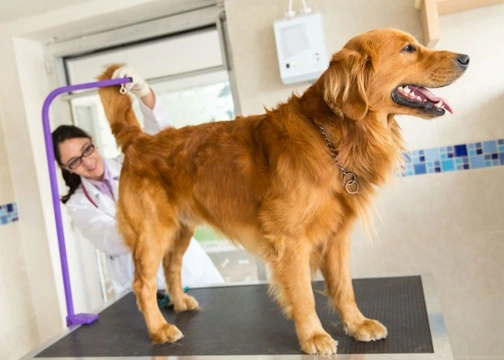
Anal gland problems in dogs
If you’ve ever seen a dog performing a scooting motion along the ground where he appears to be paddling with his back legs in the air and dragging his bum along, it’s probably made you wonder what on earth he’s doing!
Vets, veterinary nurses and dog groomers all regularly check and express their canine customer’s anal glands as part of their day-to-day jobs, and anal gland problems, blockages or impactions in dogs are relatively common. Many pet owners are also trained and conversant in emptying their dog’s anal glands themselves, although this can be messy, smelly and unpleasant, hence often being left to the professionals!
Generally, anal gland issues, while uncomfortable, are not normally indicative of a serious condition, but if left untreated, anal gland problems may eventually lead to infections, abscesses and other complications.
If you’re not sure what or where your dog’s anal glands are, how to tell if there’s a problem with them or what to do about it, read on to learn more!
What are the anal glands?
Your dog’s glands (also sometimes referred to as the scent glands) are a pair of small sacs located on either side of the anus, between the internal and external sphincter muscles. These glands are what allow your dog to mark his territory with his own unique scent, and differentiating between the different scents of different dogs is a big part of how dogs communicate. The anal glands are also the reason for why dogs, upon greeting, will often sniff each other’s back end, usually much to the chagrin of their owners! All dogs and bitches, both neutered and entire, have anal glands, and so may be susceptible to having problems with them.
Why do some dogs suffer from anal gland problems?
When your dog defecates, the anal glands generally empty at the same time. The faeces of dogs are firm, and this exerts enough pressure upon the anal glands to force them to empty. However, if your dog is passing soft stools, this may not exert enough pressure to empty the anal glands on their own.
This causes an uncomfortable build up of pressure from the full anal sacs pressing upon the anus, which is what often leads to dogs dragging their butts along the ground to try to relieve the pressure.
Left unchecked, over time anal glands that are not emptying fully or correctly can become impacted with a hard build up and blockage of the ducts leading to the opening of the glands, which can eventually lead to pain, swelling, formation of abscesses and infection.
What are the signs of anal gland discomfort?
As well as the classic ‘scooting’ motion that is generally indicative of anal gland impactions or problems, there are a range of other signs and symptoms to be on the lookout for.
- Scooting or dragging the back end along the ground.
- Your dog persistently licking or biting at the anus.
- Difficulty sitting down, or appearing uncomfortable when seated.
- Persistent out-of-character chasing of the tail.
Expressing the anal glands
The technique used by vets, veterinary nurses, dog groomers and some dog owners to manually empty the anal glands for a dog who is having problems is known as ‘expressing the anal glands’ or an anal gland expression.
Any veterinary practice and the vast majority of dog groomers can be hired to do this for you. Many pet owners also choose to learn this technique and carry out the procedure themselves, although an equal number prefer not to as it can be smelly and messy! Also, not all dogs will put up with having their anal glands expressed without complaint, particularly if it is causing them pain or discomfort, so you may be better off going to a professional! If you do intend to perform the procedure yourself, it is important to be shown and taught how to do this properly by your vet or dog groomer, in order to ensure that you get things right first time and do not unnecessarily prolong the procedure or make it more uncomfortable for your dog.
Preventative measures
While the majority of dogs will live out their lives without suffering from any problems with their anal glands at all, a significant number of dogs will nevertheless have a problem at some point, and for some dogs, attention will need to be paid to their anal glands on a regular basis to prevent build-ups and ongoing problems.
If your dog suffers from anal gland issues due to passing stools that are softer than they should be, this may be something that you can address by means of changing their diet. A high protein diet and simple trial and error with the aim of finding a suitable complete food that changes the consistency of their stools may be enough to resolve an ongoing problem.
In the vast majority of cases of dogs with anal gland problems, the dog will still pass normal stools, and so changing their diet may not be helpful.
If your dog suffers from ongoing or recurrent anal gland problems, it is important to get this checked out by your vet (even if you are competent and willing to express the anal glands at home). It is important to do this in order to ensure there is no underlying problem causing the issue, or any secondary infection or growth that may be exacerbating things or leading to recurrences.



